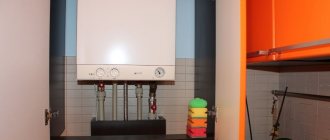A gas sensor for a home is a necessary device that can monitor the level of gas pollution in a room. Thanks to a special internal device, when a leak appears in a house or apartment, the alarm will emit a specific signal that will help the owner notice that there is an accumulation of carbon or natural monoxide in the room. In this publication, we will consider not only what types of devices there are, but also the rating of the best models. At the end of the article you will also find a recommendation on which model is better to choose and why.
A compact sensor that determines the degree of gas pollution in a room Source tele-art.ru
Types of signaling devices
In total, there are two types of sensors that monitor the level of gas pollution in the room: a device with a valve and a device with GSM control. Each of them has individual characteristics. Let's look at two options in more detail:
- Gas sensor with valve. This is an independent device that can not only detect a leak, but also eliminate its possible consequences (explosion, poisoning). This is ensured using a shut-off valve placed inside, which blocks the supply of blue fuel to the heating equipment or gas stove. Such devices are characterized by increased safety, but have a significant drawback - there is a possible risk of false alarms, for example, if tobacco smoke or street fire has entered the room. For household services, a sensor with electromagnetic control is used. That is, when a leak is detected, a signal is sent to the receiver, and the device, using electrical energy, prevents further gas from entering the room. Powered by electricity.
- GSM control. This sensor option is no less popular and is suitable for those who constantly use smartphones or other compact gadgets. Such a detector can be synchronized with a mobile phone using GSM networks, as a result of which, in the event of a leak, notifications, calls or SMS will be sent to the phone. Such applications even have the ability to remotely control the current situation (turn off the gas supply, etc.).
Of the listed types of sensors, the GSM version will be more expensive, but it will be more effective. It also has its downside. If a person is in an inaccessible area to receive a mobile signal, then the alarm notification will not reach the owner of the house in a timely manner.
Gas analyzer with GSM control Source onlinetrade.ru
Operating rules
After installation, it is worth observing the device for some time.
For efficient and correct operation of the device, it is important not only to install it correctly, but also to properly care for it:
- Regularly wipe off dust from the device, but do not overdo it so as not to damage the sensor;
- do not allow the surface to become clogged;
- periodically test the sensor, for example, with gas from a lighter;
- If a model with a valve is installed, periodically check it for operation.
Attention! After checking the operation of the shut-off valve, do not forget to return it to its operating position.
Rating of the best sensors as of 2021
In this section we offer a detailed rating, which includes device models that deserve attention. Each device will be reviewed in a table that will provide a detailed overview of the features, as well as the pros and cons of each specific device.
| Place in the ranking | Model | Description of features | Advantages and disadvantages | Price as of March 2022, rub. |
| 1 | Xiaomi Mi Honeywell Gas Alarm | The detector, which best determines gas pollution in a room, is highly sensitive to methane leaks. There is the possibility of light, sound and GSM notification. | Pros: convenient case; clearly visible signal; ease of use; fast reaction. Cons: one of the expensive models; does not “feel” carbon monoxide and other harmful fumes. | 3 270 |
| 2 | Rubetek KR-GD13 | A convenient, compact device that is not very noticeable. Has a screaming siren that can be heard at the opposite end of the house. Suitable for mansions and country cottages. Gives a sound signal and sends SMS messages and Push notifications to your smartphone. | Pros: compact; multifunctionality; comfortable notification system; ease of operation; clear interface. Cons: too high sensitivity. | 2 980 |
| 3 | First Alert OneLink GLOCO-500 | An advanced gas analyzer that works via Wi-Fi and has the ability to connect to a smartphone or tablet using a special application. The sensor model is considered universal because it can also indicate a lack of CO in the air. | Pros: multifunctionality; high sensitivity; Wi-Fi support; displays deviations from the norm. Cons: too high price. | 5 310 |
| 4 | Bradex Guardian | The device is suitable for installation in any room. Capable of sensing leaks of natural, carbon dioxide, and carbon dioxide. There is a built-in catalyst inside the device, which heats up when there is a minimum concentration of gas in the air. | Pros: high sensitivity; a loud enough signal; able to function in different conditions; works stably on electricity. Cons: there is no way to send a signal to a smartphone. | 1 090 |
| 5 | Alfa 501 | Model of the sensor equipped with a shut-off valve. It is a fairly sensitive unit, it perceives from 0.1% of gas in the air. Designed for installation in rooms where gas equipment is installed. | Pros: operational efficiency; convenient functionality; fast installation that does not require professionalism. Cons: at high temperatures it can produce failures and false signals. | 2 690 |
| 6 | Bastion B40 DG | The equipment is intended for installation on the wall; they try to install it directly next to gas appliances. Operating temperature range -10-+45 degrees. | Pros: powerful detection system; high sensitivity; interacts with other protective systems in the house; compact body. Cons: can only sense the concentration of natural gas in the air. | 800,00 |
| 7 | Testo 317-2 | The unit, which does a good job of detecting leaks in pipelines, uses built-in batteries to maintain operation at all times. All measurement results are displayed on a small LCD monitor. | Pros: quick response; convenience; ease of operation; ability to work autonomously; high accuracy of readings; durable body; high sensitivity. Cons: duration of inclusion; high price. | 14 900 |
What is a gas alarm?
A gas alarm is a small device equipped with a sensor. The sensor operates on the basis of a particularly sensitive element. This element continuously scans the gas content in the air and, if an unacceptable level is detected, produces an audible signal.
Gas alarm device
Alarms are available for industrial and household purposes. The first type is used in manufacturing, industrial premises, catering establishments and other non-residential buildings. For the safety of residential premises, household sensors are used.
Note! The sensitive element inside the sensor can detect the content of gases such as methane, monatomic or diatomic carbon oxides.
Best areas for equipment installation
To install a gas detector, they try to choose the room in which the gas equipment is directly installed. Places for mounting the sensor can be:
- kitchen. In this room, it is advisable to fix the device directly next to the heating device, gas stove or gas main. Moreover, it is desirable that the device is located at a good distance from open fire;
- living room. In this residential area, it is allowed to install the analyzer device on the ceiling surface or a free section of the wall. If there is no equipment in this room, then it is best to use the high sensitivity option;
- bedroom. Since people mainly relax in this room and may not feel a leak, installing a gas analyzer here is simply necessary. It is best to place the sensor above the door in this room;
- loggia. This is the room in which it is necessary to have at least two sensors or one that is sensitive to all types of gas, including methane and carbon monoxide. It is desirable that the controllers be additionally equipped with a shut-off valve.
Installation of a gas leak sensor is also possible in the corridor or hallway. Here they try to place the device at the top point of the wall or ceiling.
The gas sensor can be installed under the hood, provided that it is 1 meter away from the gas stove Source kupisantehniky.ru
A gas analyzer with a built-in plug can be installed in an outlet located near the hood or near gas equipment Source medtech-perm.ru
On a note! It is fundamentally wrong to install a gas alarm in a corner, in closets, or near roller blinds or Roman blinds. It is not advisable to place the device in a window opening. The result is incorrect operation of the device.
A compact and ergonomic sensor for analyzing gas leaks can be installed in the bedroom or living room Source onlinetrade.ru
LPG gas sensor module
This module contains an MQ3 sensor, which detects LPG gas, and a comparator (LM393) for comparing the MQ3 output voltage with the reference voltage. When LPG gas is detected, it outputs a logic high voltage. The potentiometer is used to adjust the gas detection sensitivity. This module is very easy to use with microcontrollers and Arduino and is readily available commercially under the name "LPG Gas Sensor Module". We can also assemble it ourselves using LM358, LM393 and MQ3.
LPG gas sensor module
Rules to be followed during installation
Often, a device that monitors gas leaks in the house is installed in the kitchen or dining room (if there is one). For example, the most popular heating source today is natural gas.
Since during leaks it tends to accumulate in the upper part of the room (that is, under the ceiling). Consequently, the installation of monitoring equipment must be carried out approximately within this perimeter. It is also important to know several prohibitions regarding the installation of sensors:
The gas sensor is often mounted on a factory-provided strip or directly plugged into an outlet. Source m.onlinetrade.ru
- near an open fire - a minimum distance of 1 m or more.
- near windows, ventilation shafts, chimneys;
- near areas where fat may form, droplets of moisture;
- close to the place where flammable materials are stored (paint, alcohol, kerosene, gasoline).
It is noted that the installation height of the device is selected depending on the type of device. In this case, it is necessary to focus on the characteristics specified in the instructions for use.
Gas analyzers should not be disassembled yourself unless absolutely necessary Source m.onlinetrade.ru
Types of devices
Sensors can respond to different types of gases.
Based on the type of fuel consumed, devices are divided into the following types:
- natural gas content analyzers;
- carbon dioxide detectors;
- carbon monoxide detectors;
- combined devices that react to different gases.
The last type is the most popular and versatile, as it is able to provide maximum security. Combined devices simultaneously detect the presence of methane and carbon monoxide in the atmosphere, preventing explosions and poisoning.
Modern devices are further classified according to the method of determining gas concentration:
Catalytic (thermocatalytic)
The surface of the sensitive element of these devices is covered with a layer of catalyst: tin dioxide, platinum, palladium. When there is a leak, the gas oxidizes under the influence of oxygen and heats the sensor. This triggers a signal.
Semiconductor
They are triggered by a sharp decrease in the resistance of the tin oxide sensitive element. The speed of the sensor is ensured by a heater - a resistive layer of inert materials.
Electrochemical
Filled with a solid or liquid electrolyte that acts as a heating element.
Infrared
The environment within the infrared spectrum is analyzed. During operation, the reference and test waves are subject to analysis. Two media pass through the light source and return to their original position. The device then analyzes the signals and shows the gas concentration in the room air.
Such models of alarms are mainly used in industry. They have advantages over catalytic ones: they turn on quickly and consume little electricity.
Depending on the type of power supply, sensors are of two types:
Wired
They operate from a network of 220 - 230 V. Many people assume that wired sensors are dangerous, since if shorted, a large amount of gas in the OS can lead to an explosion. This is not entirely correct. This type of device is made according to special technology, so an explosion due to a short circuit will not occur.
Wireless
To operate the device, a battery is required, which is built into the case, due to which such a sensor can be installed anywhere. It consumes a lot of energy, so it is not used in industry. In addition, this type of device is distinguished by its high price.
Alarms with valve
This type of sensor not only gives a signal about danger, but also independently takes measures to eliminate it.
The device is equipped with a valve that stops the gas supply when its maximum concentration is formed in the air. Electromagnetic devices controlled by an electric pulse are intended for everyday use. They are in the same electrical circuit with the gas alarm.
If an alarm situation is created, a signal is sent from the sensor to the valve. The device instantly triggers a mechanism that blocks the entrance to the gas supply pipeline.
In a valve operating from an electrical impulse, the signal is sent to an electromagnetic coil, the core of which, with its movement, according to the physical law from the field of electromagnetic induction, affects the closing mechanism of the valve.
Tips for choosing a device
In order not to make a mistake when purchasing a room gas sensor, you must follow some rules regarding the choice. In order not to get confused in them, in this section we suggest you figure out what exactly you should pay attention to.
- Service life of sensors. This is stated in the technical documentation. It is believed that the longer the device lasts, the better; accordingly, such a model will cost more. But you need to monitor the sensors more often, as it may be necessary to replace them due to failure.
- Availability of a tester. Almost every piece of equipment has a built-in tester that can determine how functional the device is at the moment. The most convenient option is the one with a button. When pressed, the device automatically performs a self-test.
- Availability of a certificate. Before purchasing a gas analyzer, make sure that the documentation for it includes a certificate of verification work, as well as a document confirming that the device has passed metrological studies and testing.
A typical compact gas alarm for a home or apartment Source onlinetrade.ru
In addition, when choosing alarms, pay attention to a number of parameters outlined below:
- type of gas: methane, liquefied, carbon dioxide;
- sensitivity: in relation to CO - 20 mg/m3, fuel - 10%;
- types of sensors: chemical or physical;
- period of operation - from 10 years;
- The service life of sensitive parts is 3.5 years.
There is always the opportunity to pay attention to more expensive models with a certain set of additional functions.
Criterias of choice
Gas alarms are selected according to the following characteristics:
- Type of gas being determined: natural gas (methane, CH4), liquefied gas (propane-butane), carbon monoxide (carbon monoxide).
- Sensor service life. As soon as it runs out, the device will need to be changed. The average service life of devices is 10 – 15 years. Accordingly, the larger it is, the better.
- Features of testing. During operation, you will have to periodically carry out this procedure. It is better to choose a device that is tested at the touch of a button.
- Sensitivity, that is, the response threshold. Recommended values: 10% LEL for gas fuel, 20 mg/m3 for carbon monoxide; by type of sensor - gas-sensitive sensor: the operation of sensors for the same gas can be implemented on different physico-chemical principles.
- Service life of sensors. It is smaller than the device as a whole. Therefore, this element will need to be replaced in order to operate the sensor for some more time. When purchasing a device, inquire about the cost of new sensors from a specific manufacturer. The frequency of sensor replacement is from 3 to 5 years.
- Additional functions. For example, there are devices with a GSM module for instant notification of gas leaks using SMS and push notifications directly to a smartphone or devices with self-diagnosis and fault indication, as well as devices with contacts for turning on an exhaust fan or an additional detector.
There are no general recommendations about the quality and price category of household alarms. By choosing an expensive model, the owner of the premises receives a more reliable, sensitive and durable device. But some cheaper options are also worthy of attention and will last the entire period guaranteed by the manufacturer.
It is also important to consider that high-cost models may have additional functions:
- accurate determination of the critical gas concentration in the air;
- prompt notification of emergency services about a gas leak;
- notification of the apartment owner via cellular communication.
Low-price sensors do not always cope with their task. Often a response occurs only when there is a serious and already dangerous gas leak. Sometimes appliances react to an increase in ambient air temperature that occurs during cooking.
Attention! The sensor passport must contain a special mark indicating that it has passed metrological verification. Check its availability when purchasing, otherwise you will have to pay for verification of the device before putting it into operation.
Features of choosing a shut-off valve
2 types of valves can be connected to the alarm:
Normally closed
They shut off the gas when the sensor is triggered and when there is a power outage. Before operation begins, energy is supplied to the valve and alarm. It is held in the open position by an electromagnetic coil. In the event of a power failure, the voltage on the coil disappears and the valve closes. After reapplying voltage, the valve must be manually cocked again.
Normally open
They operate only in response to a sensor signal. Before starting operation, power is supplied to the sensor and the valve is charged. In the initial position, the coil is de-energized and the valve is held open by a mechanical latch. It does not respond to a power outage, and the gas supply does not stop. The valve closes only after receiving a gas signal.
Upon return to operating condition, the valves are divided into manual and automatic. In private homes, it is enough to install less expensive types with manual cocking.
The shut-off valve is selected according to the following parameters:
- type of gas: natural gas (methane, CH4), liquefied gas (propane-butane), carbon monoxide (carbon monoxide, CO), dry non-aggressive gases;
- normal valve position;
- gas pipe diameter at the valve connection point: 1/2′′ (DN 15), 3/4′′ (DN 20), 1′′ (DN 25), 11/4′′ (DN 32);
- mains voltage: 220 - 230 Volts.
The type of valve, normally open or closed, is selected from the following considerations:
- For a gas boiler or hot water heater that stops working if there is no voltage in the electrical network and automatically resumes operation after voltage is applied, a normally open valve is installed on the gas pipeline.
- A normally closed valve is installed on the gas pipeline for a gas stove, as well as a boiler or water heater, the operation of which does not depend on the presence of voltage in the electrical network. It will shut off the gas while there is no electricity in the house. This is necessary, because if there is a power outage, the gas alarm will not work, and the house or apartment will be left without its protection. In order not to experience discomfort from the lack of light and gas in the house, it is recommended to connect the gas alarm to the mains via a UPS - an uninterruptible power supply.
Why does a gas leak occur in a house or apartment?
Natural gas leaks occur for various reasons. For example, due to the negligence of the owners of the house, as well as in the event of a malfunction of the equipment or the main line (the shut-off valve does not work, the seam on the pipe comes apart, the connections of the counting equipment occur.
This may also be due to a blockage on the burner of the gas boiler or stove. As a result, the ignition does not work, the owner does not notice this, and then a leak of blue fuel occurs.
A gas leak in the house can lead to irreversible consequences, so the detected malfunction must be corrected in a timely manner Source ekburg.tv
It is also possible for combustion products to accumulate in the chimney. The resulting soot tends to ignite, which is why it is possible not only to disrupt the draft from the pipe, but also to cause an explosion of gas equipment.
Therefore, in order to protect yourself and your loved ones, it is necessary to carry out annual preventative maintenance on your boiler and gas stove. It is also necessary to order maintenance of gas equipment from a professional service. Ideally, it is better to address this question to the company directly involved in the installation of your equipment.
Carrying out a technical inspection should be trusted only to gas workers Source artemgaz.dn.ua
Code
#include LiquidCrystal lcd(3, 2, 4, 5, 6, 7); #define lpg_sensor 18 #define buzzer 13 void setup() { pinMode(lpg_sensor, INPUT); pinMode(buzzer, OUTPUT); lcd.begin(16, 2); lcd.print("LPG Gas Detector"); lcd.setCursor(0,1); lcd.print("Circuit Digest"); delay(2000); } void loop() { if(digitalRead(lpg_sensor)) { digitalWrite(buzzer, HIGH); lcd.clear(); lcd.print("LPG Gas Leakage"); lcd.setCursor(0, 1); lcd.print(" Alert "); delay(400); digitalWrite(buzzer, LOW); delay(500); } else { digitalWrite(buzzer, LOW); lcd.clear(); lcd.print(" No LPG Gas "); lcd.setCursor(0,1); lcd.print(" Leakage "); delay(1000); } }
Features of servicing the sensor at home
The gas detector, installed and operated in accordance with the requirements specified in the manual, does not require special maintenance or replacement. Often it is enough to simply replace the receiving grids and check the functionality of the sensors, as well as test the device itself. This is quite doable without special help at home.
On a note! If third parties offer you to install a gas analyzer in the pipeline, you should not immediately agree. These could be scammers who will supply a device that does not work. The best option is to purchase the equipment yourself, and then contact the gas service at your place of registration with an application to install the purchased sensor.
Professional leak testing is carried out by special workers using special equipment Source freeassociateprograms.com
Features of work
As soon as the gas supply is stopped and its concentration drops to normal, the signal will stop and auxiliary devices will be activated. After this, the indicator returns to normal measurement mode. As soon as the cause is eliminated, either on your own or with the help of the gas service, it will be necessary to restart the heating and heating equipment.
Equipment that can be connected to a gas sensor
A gas leak detector for a home or apartment can work with several types of shut-off valves:
- closed. This is a reliable equipment option that is triggered when the analyzer detects a leak. As a result, it simply stops supplying fuel to the sources; The only disadvantage of this sensor is that it stops the gas supply when there is a power outage to which the analyzer is directly connected;
- open. They only operate when leaks are detected. When the device is disconnected from the power supply, gas continues to flow through the pipeline to the equipment. Therefore, when the lights are turned off, this device is not able to secure the situation;
- pulsed. The shut-off valve is not cheap. Triggered when an electrical impulse is received by the latch holding the crossbar in the open position. When the cut-off valve is activated, gas does not flow further into the pipe located in the room. The valve will need to be opened manually if an automatic mechanism is not provided.
For a house or apartment, pulse shut-off valves in combination with a sensor are most often used. Moreover, they are controlled manually. This option is considered cheap and convenient for home use.
FAQ
A gas leak detector was installed in the boiler room, which often triggers falsely. We checked the sensor itself - it is working. I don’t want to turn it off, but I’m tired of listening to the siren. How to solve a problem?
If ventilation is properly organized in the boiler room, then the boiler burner may be clogged. In this case, during startup, gas is released, to which the sensor reacts. Call a specialist to carry out boiler maintenance.
Gas services force you to install a gas leak detector in your apartment. Is its installation required by law?
No. The homeowner makes the decision about the need to install a sensor independently. No one has the right to oblige him to do this by law. Imposing services for installing sensors in accordance with Art. 16 of the Law “On Protection of Consumer Rights” of 02/07/1992 is prohibited.
We moved into a house and there is a gas sensor and valve on the gas pipe. It activates and shuts off the gas when something is baking in the oven. There is no smell of gas. What could be the reason and can it be removed?
If the sensor is only for flammable gas, it cannot operate during frying and baking. If it is combined - flammable and CO - then there may be a malfunction and it needs to be checked or replaced. You should not remove it without permission, since, most likely, the device is provided for by the design.
Diagram of the correct operating principle of the device
Below is a diagram according to which it is best to install complex equipment (gas analyzer and shut-off valve). We invite you to consider in more detail:
- gas valve, installed on the inlet pipeline in front of the equipment;
- a control signal is sent from it to a leakage sensor located nearby and powered into an outlet;
- connected equipment: siren (speaker), ventilation, illuminated display, which is clearly visible at any time of the day.
Traditionally, a leak control system is designed in this way.
Almost every gas analyzer is installed according to the same scheme, unless otherwise provided by the manufacturer Source St. Petersburg.portal-avtomatika.rf
How does a smoke detector work? Why does a smart home need it?
The sensor works like this: when the permissible smoke concentration increases, the siren turns on. In the Smart Home system, an alert will be sent to the user’s mobile device.
If you program the system and install additional equipment, the “Fire” scenario will start.
For example, emergency lighting and light signaling will turn on, the smoke removal system will start, and the valves of gas equipment will close. To quickly leave the house at night, the stairs will be illuminated. A call to the fire department will also be sent.
So which model should you choose?
In the above rating, several models of gas analyzers are considered. Some of them are functional because they are sensitive to leaks of various substances. Moreover, all devices have advantages and disadvantages.
When purchasing a gas analyzer, you need to make sure that everything necessary for installation is included Source m.onlinetrade.ru
The gas sensor must be equipped with special fasteners: screws, dowels Source m.onlinetrade.ru
What equipment can the Smart Home system control?
"Smart home" can control:
- heating system;
- water supply system;
- electrical system and electrical equipment;
- video surveillance system;
- leakage, gas leakage, smoke, motion and light sensors;
- security system;
- multimedia audio and video devices.
In a normal home, these systems operate independently of each other. In a “smart” one, they are connected to each other in a single network, under common control, which directly affects the level of comfort and convenience of life in a country house. The number of possible scenarios and, accordingly, sensors and actuators depends on the needs of the smart home user.
Sensor for a summer residence
A carbon monoxide sensor for a bath is selected and installed according to the same principle. In addition to this equipment in the house, you can connect fume hoods and hoods, which may be located above the hob. The connection diagram of such a device to the sensor will be less expensive. It will only be important to connect the wires that go to the sensor relay contacts in parallel to the connection button.
Installation Features
A carbon monoxide detector for your home can be installed on the mounting bracket that comes with the device. The latter connects to a 220 volt household network, and if you are interested in uninterrupted operation, you can choose a signaling device model that has a function of switching to backup power. This may be necessary when the mains power is cut off. The master will have to additionally install a backup source with recharging of the IRP-1 brand. You can purchase a device that runs on an internal battery. However, experts consider it a more expedient solution to use equipment that operates on a 220-volt network, because in this case there is no need to monitor the performance of the battery, as well as periodically replace it.
Regarding the availability of heating and heating equipment, it is best to choose devices that are equipped with the ability to automatically switch to autonomous power.
Need for use
A household carbon monoxide sensor is simply necessary when a family has a country house or house heated by boilers, stoves or fireplaces using liquid or solid fuel. The possibility of carbon monoxide accumulation when using this type of fuel is especially high. In some cases, there is a need to heat the house while the owners stay overnight. Experience in handling such devices that operate on solid or liquid fuels is often not enough. It is best to install a non-sleeping electronic sensor, which may be the simplest. Here we are talking about the SGB-1-4.01 brand.
The device will be sensitive to the accumulation of poisonous gases, and if such a situation occurs, it will sound an alarm. It is also important to note that all devices of the SGB-1 brand have LED sensors on the front panel, which visually allow you to determine what state the alarm is in at a certain moment.











